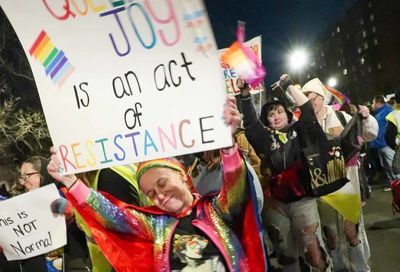Election 2022: The Tipping Point of D.C.’s Initiative 82
D.C. will vote -- for a second time -- on whether to eliminate the current wage structure for tipped employees.
By John Riley on November 7, 2022 @JRileyMW

After years of legal wrangling and political machinations, D.C. voters will once again, for the second time in four years, be faced with a ballot initiative that would eliminate the local restaurant and bar industry’s current tipped-wage structure.
If this seems like déjà vu to you, you’re not alone. Here’s what happened.
Following the passage of Initiative 77, a measure to eliminate the subminimum wage in 2018, the D.C. Council overturned the will of the voters and reinstituted the current wage structure.
As of last June, every employee in the District of Columbia makes the minimum wage of $16.10 per hour. Tipped workers get a base wage of $5.35 per hour, on the assumption that their tips will either supplement their wages, or, in some cases, exceed $16.10 per hour.
If an employee’s tips don’t cover the difference between the sub-minimum wage of $5.35 and $16.10, employers are required to pay the worker the balance of what remains. So, for example, if a worker’s tips over the course of a shift only add up to $14.10 per hour, a bar or restaurant owner is supposed to pay the worker an additional $2 per hour to ensure they are making at least the minimum wage.
Opponents of this current structure, led by the nonprofit group One Fair Wage, argue that tipped workers should make a base pay of $16.10 per hour, and then be awarded with tips on top of their hourly wages, based on the quality of service they provide. To accomplish this, they have pushed for a voter initiative that would institute the type of wage scale they prefer.
Bar and restaurant business owners, as well as many tipped workers, have come out in opposition to the ballot measure, known as Initiative 82, arguing that requiring the business to pay a larger base wage results in increased costs, which eventually have to be passed on to consumers in the form of service charges or price increases.
They also argue that the imposition of service charges, in particular, will lead customers to either not tip or tip significantly less, thereby decreasing the amount of take-home pay that servers or bartenders are currently receiving. Some opponents have even speculated that passage of Initiative 82 will lead to reduced hours and fewer staff due to the financial burdens that establishments may face.
“We’re stuck with an initiative that forces voters to rely on political messaging and make a yes-or-no decision on an issue that’s really complex,” says John Guggenmos, the co-owner of Number Nine and Trade. “I personally think we should not have initiatives, that we elect our representatives, our Council members to sift through these complicated issues, to debate them, and come out with a reasonable policy that is good for the District. But that’s not what we’re faced with.”
Guggenmos says that the biggest problem, should Initiative 82 pass, is that eating and drinking establishments will have to spend more on payroll, with the costs getting passed onto the consumer.
“The problem with this initiative is that you cannot just snap your fingers and magically produce income,” he says. “This is going to dramatically increase the costs on restaurants and bars, and we just can’t pretend that those costs don’t exist.
“We’ve seen a few restaurants already go to a service charge model, and that’s probably what you’re going to see with a vast majority of them. But the problem is that the service charge is subject to sales tax. So you’re not paying $20 on that hundred-dollar check. You’re paying $22 because two more dollars goes to the district.
“Sales tax revenue service charges are subject to sales tax. If a restaurant chooses to increase prices again, that’s being passed onto the public. And that increase, again, is being passed onto the public, and is subject to the sales tax increase. A gratuity is going to be subject to sales tax…. A tip is legally the bartender or the server’s.”
Guggenmos takes issue with the wording of the ballot initiative, in that it appears to imply that servers and bartenders are not currently making minimum wage.
“If workers don’t make whatever the difference between the [D.C.] minimum wage and the tipped minimum wage is during their shift, the business is [currently] obligated to pay that. So everyone makes minimum wage in the District. Period.”
Because of the success of Initiative 77 four years ago, which passed by a more than 10-point margin, opponents of Initiative 82 sought to challenge the validity of petition signatures needed to get the measure on the ballot. After months of legal wrangling, the D.C. Board of Elections certified the initiative — a decision that the D.C. Court of Appeals eventually upheld.
Alex Morash, the national director of policy and communications for One Fair Wage, told Metro Weekly the fact that opponents tried to sideline the initiative on technicalities, rather than argue the merits of the proposal, tips their hand and shows that they do not believe they can change voters’ minds through persuasion.
“I think it shows how little respect they have for D.C. voters,” says Morash. “This was on the ballot and voters approved and eliminated the subminimum wage in 2018. And opponents went afterwards to the D.C. Council to try and do an end-runaround. At the end of the day, D.C. voters get to have their say. And that’s what this should really be about, is letting the voters make this decision.”
Morash says that, ironically, the pandemic shutdowns — which members of the business community have argued were allowed to go on for too long and did more long-term harm to the local economy — may have actually led many voters to conclude that tipped workers should be guaranteed a more stable level of income.
“I don’t think voters are really going to change their opinions on eliminating the subminimum wage,” Morash says. “The thing that we hear the most when talking to workers, supporters of I-82, is people who went through the pandemic and really feel like they want to have a much more stable baseline wage. They want to have that basic security.”
Citing a poll of 300 restaurant workers conducted last year by Lake Research Partners, Morash says respondents were overwhelmingly in favor of starting with a base wage of $15 or $16 per hour, with tips from customers on top. (Critics have responded that the sample size of the poll, and the wording of the questions in it, render its findings obsolete.)
“I think the pandemic, at the end of the day, was one of the real big change factors,” adds Morash. “The restaurant industry has had a labor shortage lately, and I think a lot of that is due to people really wanting to make sure that they have a job that has a consistent basic wage and are going to be treated decently.”
Ryan O’Leary, a former D.C. restaurant server who was laid off during the pandemic, and a former paid organizer for One Fair Wage, argues that seven states — Alaska, California, Minnesota, Montana, Nevada, Oregon, and Washington State — have eliminated the subminimum wage, without disastrous consequences befalling the restaurant industry.
“If you look at the restaurant industries in all these states, they’re thriving,” he says. “They’re doing as good, if not better, than in Washington, D.C. And more importantly, the restaurant workforce is doing better in those states. I have friends who waited tables or bartended in D.C. and drank the Kool-Aid of their managers’ arguments during Initiative 77. Since then, they’ve moved out to California and they’ve said to me, point blank, ‘I can’t understand why I was ever against this initiative.’ They’re buying their first homes in L.A. now.”
O’Leary also feels the threat of service charges is overblown, claiming that many restaurants in D.C. have already imposed service charges to help them recoup from the pandemic-influenced shutdowns. As for his own experience, most recently working in Minnesota, O’Leary notes that restaurants haven’t been forced to resort to service charges to stay solvent.
“There’s been no evidence to show that service charges will definitely become a reality at every establishment,” he says. “And those where it is the reality, [customers] continue to tip. It’s not new for restaurants to be raising prices. They’ve been increasing them year after year, even when inflation has been low, even when the cost of doing business has gone down. And restaurant-goers rarely even blink. I’ve worked at a restaurant that single-handedly doubled all of their prices during the pandemic, and when I went back there to visit, it still looked like they had as much business as they usually had. And on top of that, now they have even more tables because of the streeteries.”
O’Leary also warns that restaurants or bars that do introduce service charges or significantly increase prices of menu items may face a backlash.
“If they try to say, ‘Sorry for this charge, it’s because of Initiative 82,’ I feel like they’re only going to get backlash, not only from the customers, but from workers. No one’s going to want to work at a restaurant where tips are so low because the owners aren’t being more enterprising in how they spend their money. You can rework your menu. You can use more seasonal local ingredients. You can make your menu items share more of the same ingredients. You can buy in greater bulk and get a lower price.
“Things change in the restaurant industry all the time: food prices, contracts, menus, chefs, all these different things change. But it’s only when it comes to labor costs that it suddenly seems so cost prohibitive and so unpalatable to somehow work it into your accounting schema that there’s no way to do it other than pass the cost onto consumers.”
Guggenmos counters, saying that expensive restaurants with higher-price menu items, or national chains, will be less affected by the shift to paying every employee $16.10 per hour, while smaller, independent restaurants will find it harder to shoulder such a financial burden. He says he’s been especially frustrated by messaging from the pro-82 side that has implied opposition to the initiative from the business community is motivated by greed.
“There’s been this perception that somehow, restaurant owners and managers don’t care about our staff. That’s just blatantly untrue. I want my workers to do well. I want to make sure I retain the best staff. But at some point, if I can’t pay the rent, if local [independent] restaurants can’t do it, and we end up getting replaced by a chain or someone from out of the area who runs it differently, then it’s no longer a neighborhood-centered restaurant.”
But O’Leary believes the hand-wringing from the restaurant industry is premature and overwrought.
“The main focus of a business is to stay in business and to make money. Businesses are not going to fall on their swords in order to prove a point by saying, ‘Oh, look, look, we can’t exist anymore because we have to pay our employees a full minimum wage, just like every other business in the city.’ They’re going to find a way to make it work,” says O’Leary.
He acknowledges that bartenders –- who generally make more in tips than other tipped workers — may not benefit as much from eliminating the subminimum wage as other tipped workers, like food runners, bussers, bar backs, nail technicians, hair stylists, and valets. Still, O’Leary insists there is a benefit to increasing their base pay to $16.10 per hour, and those who don’t like the change in pay structure can always seek work elsewhere.
“If it is really that concerning to them, if they really do feel like their livelihood is at stake, Tysons is just across the river, Bethesda is just north of us,” says O’Leary. “These places have abysmally low hourly wages for tipped workers. And so if they really think they can make more money [in Virginia] making $2.13 an hour with tips, if they think that’s better for them, I encourage them to look at those places.”
But Guggenmos says that many tipped workers currently make more than $16.10 an hour under the current system. He warns that service charges will inhibit or change people’s tipping behavior, which in the long run will essentially amount to a pay cut for those servers and bartenders.
A recent Twitter poll by Barred in DC, a website covering restaurant and nightlife news in the District, found that fewer than 1 in 5 diners would add an additional tip after being hit with a 22% service charge. A little more than one-third, or 36%, would tip on top of a 20% service charge. And 49% would tip on top of an 18% service charge.
In all three scenarios, a majority of those polled said they would not tip on top, as they do under the current wage structure.
Additionally, managers and owners interviewed for a story on I-82 in The Washingtonian earlier this month said that a minority of diners add extra gratuity on top of a service charge — which gets split among the entire staff, rather than pocketed by an individual server.
For example, Dylan Curtis, who works at the Purple Patch, a Filipino restaurant in Mount Pleasant, estimates that only 1 in 3 customers pay extra gratuity after seeing the restaurant’s 20% service charge. Elizabeth Parker, the general manager of Lutèce, a Northwest D.C. bistro specializing in French cuisine, estimates that only 1 in 5 diners at the establishment “tip on top” of the restaurant’s 22% service charge.
It’s real-life scenarios like that, says Guggenmos, that make him skeptical of Initiative 82’s claims.
“Whenever you have a large party and there’s a mandatory service charge on it, I think it’s comical that you would then leave a tip on top of it,” he says. “Yes, there’s always that one person out there who will still tip. But the majority of people won’t.”
Doechii to Headline WorldPride Closing Concert on June 8
Grammy Award-winning rapper and songwriter wraps up second day of WorldPride's Street Festival and Concert in Washington, D.C.
By John Riley on March 13, 2025 @JRileyMW
Grammy Award-winning rapper Doechii will headline the WorldPride closing ceremony on Sunday, June 8.
The bisexual singer's appearance will occur on the second day of the WorldPride DC Street Festival and Concert, expected to draw hundreds of thousands of visitors to Pennsylvania Avenue, in the shadow of the U.S. Capitol.
Admission to the festival and concert is free of charge.
The closing ceremony and concert, which runs concurrently with the Sunday festival from noon to 10 p.m., features a diverse lineup of performers, closing remarks from organizers, and the official passing of the torch to the next WorldPride host city, Amsterdam.
Sniffies CMO Eli Martin On Cruising Into the App Store
After seven years, the popular map-based cruising website Sniffies has finally launched an iOS app and it's taking off.
By John Riley on March 22, 2025 @JRileyMW
"Cruising has gotten a bad rap, especially through movies, through history, through depictions of the practice as dangerous," says Eli Martin, chief marketing officer at Sniffies, an app designed primarily for men seeking out intimate encounters with other men.
"Cruising is still an important pastime," he continues, "and is part of our culture. As men who are interested in relationships with men, we didn't want to lose that. So we couldn't be scared about calling Sniffies a 'cruising app.'"
Martin says that one goal of Sniffies was to educate people that "cruising is more than this seedy underground practice where people are thinking they might be exposed to STDs or something bad. We said, 'No, this is actually just about sex-positive people who probably have way more intention behind their sex and their sex lives.'"
Three Convicted for Murder of Two Gay Men
Three men have been found guilty of plotting to drug, incapacitate, and rob various gay nightlife patrons, resulting in two deaths.
By John Riley on February 18, 2025 @JRileyMW
A Manhattan jury convicted three men of murder for drugging two gay bar patrons as part of an elaborate robbery scheme, leading to their deaths.
The three men -- 37-year-old Jayqwan Hamilton, 32-year-old Jacob Barroso, and 36-year-old Robert DeMaio -- were also convicted of robbery and conspiracy for the drugging scheme.
Prosecutors alleged that the trio, along with other accomplices, would lurk outside Manhattan bars near closing time, hoping to encounter patrons -- primarily young men -- who were intoxicated after a night of drinking.
After chatting up their victims, the men would drug them with a fentanyl-laced cocktail and wait until they were incapacitated. The men would then steal victims' wallets and use facial recognition technology on their smartphones to gain access to bank accounts, which were then drained of money. They used those funds, as well as the victims' credit cards, to purchase various items, including liquor, sneakers, and designer clothes and accessories.
Support Metro Weekly’s Journalism
These are challenging times for news organizations. And yet it’s crucial we stay active and provide vital resources and information to both our local readers and the world. So won’t you please take a moment and consider supporting Metro Weekly with a membership? For as little as $5 a month, you can help ensure Metro Weekly magazine and MetroWeekly.com remain free, viable resources as we provide the best, most diverse, culturally-resonant LGBTQ coverage in both the D.C. region and around the world. Memberships come with exclusive perks and discounts, your own personal digital delivery of each week’s magazine (and an archive), access to our Member's Lounge when it launches this fall, and exclusive members-only items like Metro Weekly Membership Mugs and Tote Bags! Check out all our membership levels here and please join us today!
The Magazine
-
Most Popular
 'Porn Star University' Started by Gay-for-Pay Creator Andy Lee
'Porn Star University' Started by Gay-for-Pay Creator Andy Lee  Bea Arthur's Air Force Bio Purged by Department of Defense
Bea Arthur's Air Force Bio Purged by Department of Defense  Gay Porn Star Tim Kruger Dead at 44
Gay Porn Star Tim Kruger Dead at 44  Dance: Spring Arts Preview 2025
Dance: Spring Arts Preview 2025  Gay Nightclub Bans All MAGA-Related Attire
Gay Nightclub Bans All MAGA-Related Attire  Trump's FDA Cracks Down on "Poppers"
Trump's FDA Cracks Down on "Poppers"  Transgender Rights Rally at Dupont Circle on March 31
Transgender Rights Rally at Dupont Circle on March 31  Hairdressers Could Be Sued Under This Anti-Transgender Bill
Hairdressers Could Be Sued Under This Anti-Transgender Bill  Ketamine Confirmed as The Vivienne's Cause of Death
Ketamine Confirmed as The Vivienne's Cause of Death  Sarah McBride Urges Dems to Embrace Dialogue on Trans Rights
Sarah McBride Urges Dems to Embrace Dialogue on Trans Rights
 Dance: Spring Arts Preview 2025
Dance: Spring Arts Preview 2025  Transgender Rights Rally at Dupont Circle on March 31
Transgender Rights Rally at Dupont Circle on March 31  Synetic Works its Magic on Charlie Chaplin in 'The Immigrant'
Synetic Works its Magic on Charlie Chaplin in 'The Immigrant'  The Wonderful 'Your Name Means Dream' Finds Heart in AI
The Wonderful 'Your Name Means Dream' Finds Heart in AI  Gallery: The Fantastical Creations of Kitt Lauro
Gallery: The Fantastical Creations of Kitt Lauro  Female Runners Must Submit to Genetic Testing
Female Runners Must Submit to Genetic Testing  Bea Arthur's Air Force Bio Purged by Department of Defense
Bea Arthur's Air Force Bio Purged by Department of Defense  Trump Administration Kills LGBTQ Health Studies
Trump Administration Kills LGBTQ Health Studies  'Porn Star University' Started by Gay-for-Pay Creator Andy Lee
'Porn Star University' Started by Gay-for-Pay Creator Andy Lee  Hairdressers Could Be Sued Under This Anti-Transgender Bill
Hairdressers Could Be Sued Under This Anti-Transgender Bill
Scene
Metro Weekly
Washington's LGBTQ Magazine
P.O. Box 11559
Washington, DC 20008 (202) 638-6830
About Us pageFollow Us:
· Facebook
· Twitter
· Flipboard
· YouTube
· Instagram
· RSS News | RSS SceneArchives
Copyright ©2024 Jansi LLC.










You must be logged in to post a comment.